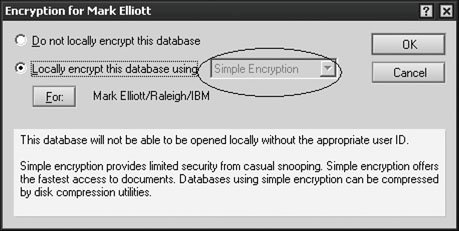Encrypt the Database
Database encryption is used to prevent unauthorized access to databases stored on the local workstation. This provides an additional layer of security for local databases or replica databases. When implemented, it prevents unauthorized access to the database. Without encryption, it is possible for a Notes-savvy person to access data on the local workstation.
Encryption works by associating a random public key with a specific user ID and appending the resulting value to the database. When implemented, only those users listed in the ACL that can also decrypt the key will be able to access the database. Database encryption has no effect on the server instance, only the local database. This process is ideal for computers that are shared with other users.
|
A.19.2 |
Although this sounds technically complex, the implementation and subsequent usage is simple. After the database is encrypted, the decryption occurs seamlessly on the local workstation. For example, if mail is replicated to a local database, you should encrypt the database to prevent unauthorized users from accessing your mail. After the database is encrypted, however, you will still be able to open and access mail with no additional steps required.
Three levels of encryption can be implementedSimple, Medium, and Strong. In most cases, Simple or Medium encryption is sufficient. Its important to note that the higher the encryption level, the longer it will take to open the database. Follow these steps to encrypt a database:
Click OK to complete the configuration. Depending on the size of the database, it will take anywhere from a few seconds to a couple minutes to initially encrypt the database. This is a one-time pass. All future encryption will be applied as documents are created and updated.



